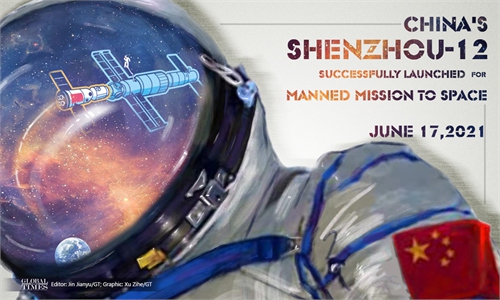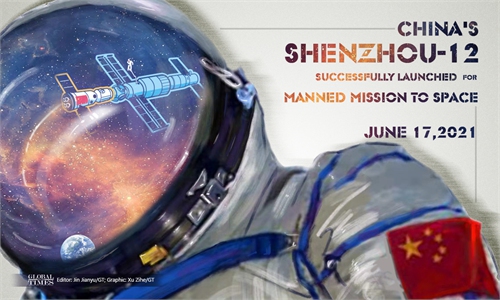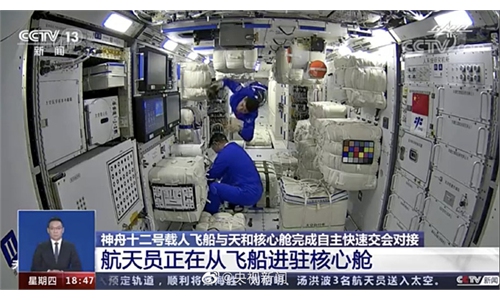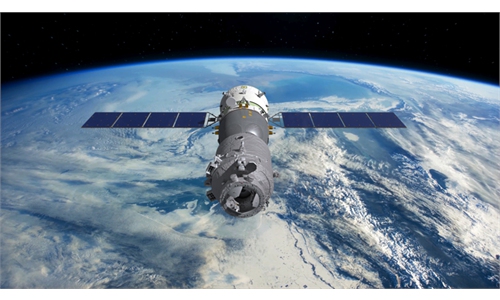China's space station core module receives first group of residents
‘Divine Vessel’ makes first fast docking for manned mission
As the three astronauts of the Shenzhou-12 manned spacecraft crew successfully moved into the Tianhe space core module at 6:48 pm Thursday, following the epic rendezvous and docking with the orbiting destination in a rapid and automated fashion, Chinese people have entered its own space station for the first time in history.
It was a much shorter and more enjoyable ride for Chinese veteran astronaut Nie Haisheng when he embarked on his third space trip on Thursday morning. The Shenzhou-12 manned spacecraft, in which Nie and his two fellow crew members were traveling, pulled off the country's first-ever automated rapid rendezvous and docking for a manned spacecraft with the orbiting Tianhe space station core module at 3:54 pm on Thursday, just 6.5 hours after the former was launched Thursday morning on the Long March-2F Y12 carrier rocket from the Jiuquan Satellite Launch Center in Northwest China's Gansu Province, the Global Times learned from the China Manned Space Agency (CMSA) on Thursday.
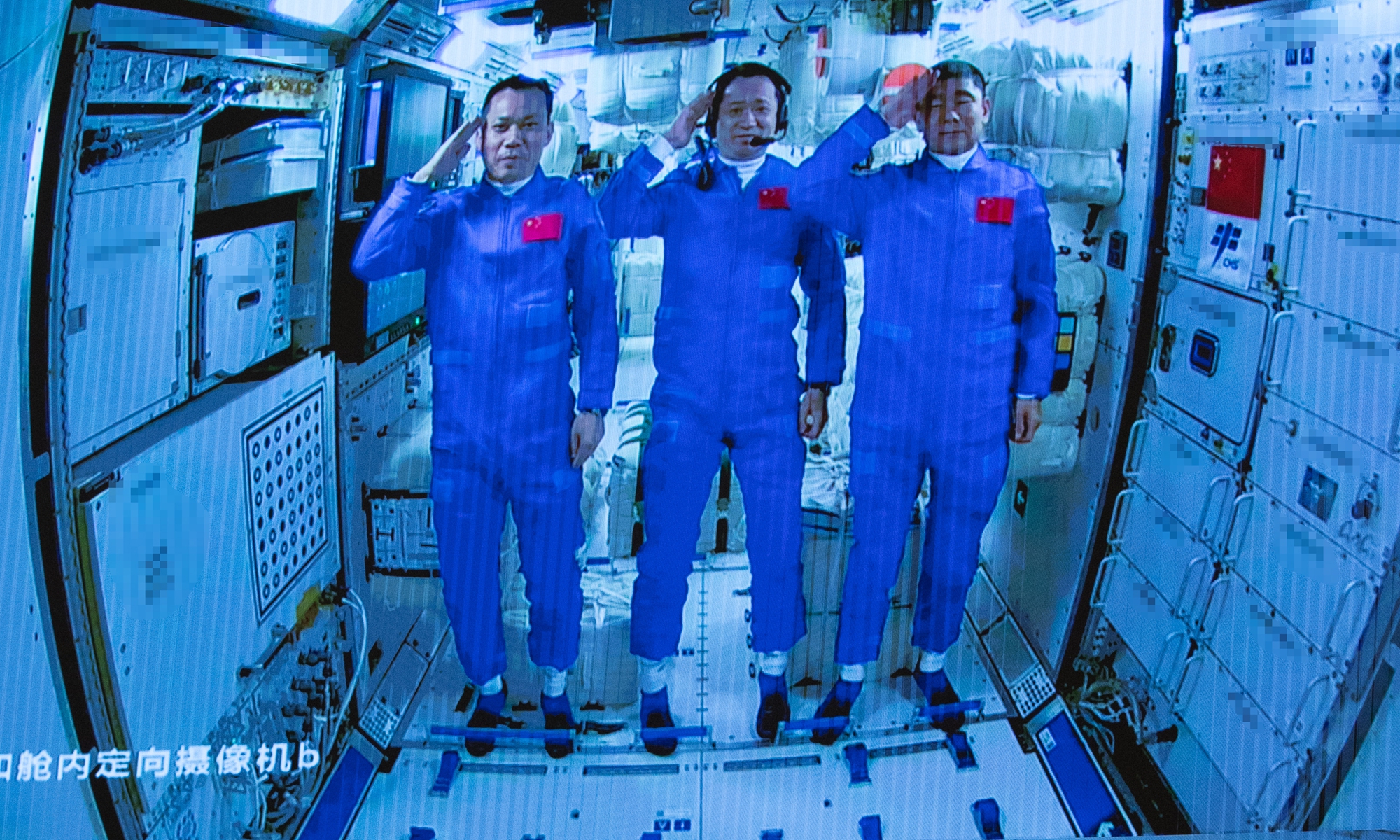
Three Shenzhou-12 astronauts, Tang Hongbo, Nie Haisheng and Liu Boming (from left) salute after entering the Tianhe core module on Thursday. Photo: Xinhua
As some may wonder why it took a few hours to enter the space station's core cabin after docking, Pang Zhihao, a Beijing-based senior space expert, told the Global Times that after Shenzhou-12's docking with the core cabin, a series of tests were conducted by the astronauts, including sealing and locking tests, leak detection, pressure balance, and air purification.
"The process takes about one to two hours each time, sometimes longer," Pang explained.
Based on the mission plan, the three new residents would conduct brief checks of their new home and rest after a long day of travel. On Friday, they are projected to open the door of Tianzhou-2 cargo craft and unbox their supplies that had arrived ahead.
The crew's smooth arrival marks yet another significant milestone in China's progress in the field of manned space travel, with the first linear complex, comprised of the Tianhe core cabin in the middle, and Shenzhou-12 manned ship and Tianzhou-2 cargo ship each at one end, now completed.
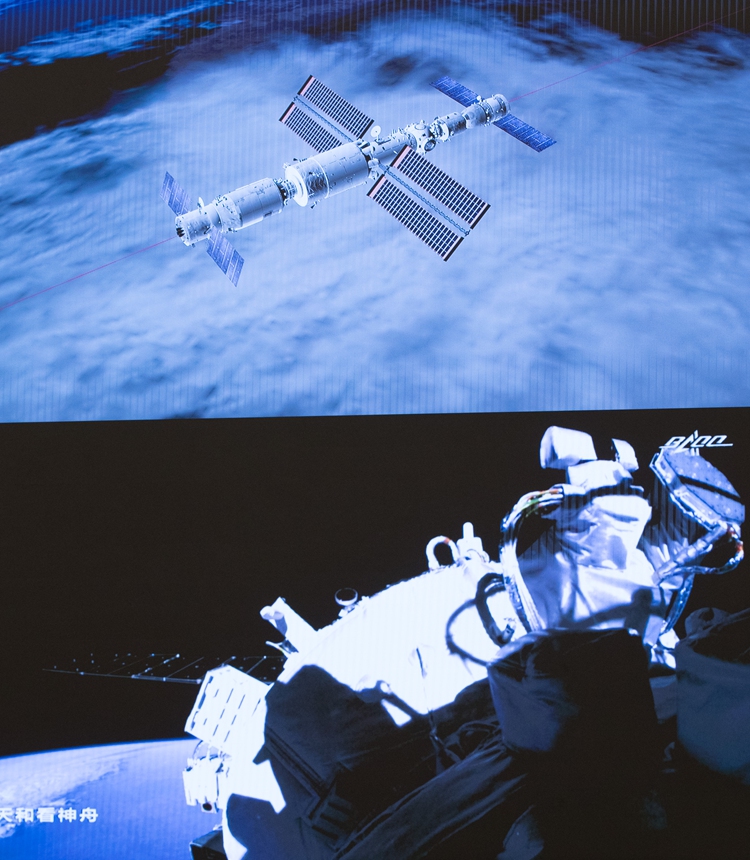
The Shenzhou-12 manned spacecraft and the Tianhe core module complete the rapid autonomous rendezvous and docking. Photo: Xinhua
The mission's launch was broadcast live on CCTV, the country's state broadcaster, and also livestreamed on China's social media platforms on Thursday morning, drawing hundreds of millions of views and soon topping the trending list on China's Twitter-like Sina Weibo.
Thrilled netizens, after five years of waiting since the last batch of astronauts visited space in 2016, brought the online community into a state of frenzy as they watched the three astronauts boarding the Shenzhou-12 spaceship.
Footage from the surveillance camera installed in the craft's cabin showed that the crew looked calm and relaxed, as Nie Haisheng, sitting in the middle with his legs crossed, waved at the camera with a big smile on his face.
Tang Hongbo, who had never traveled to space before, seemed more curious and playful. He played with a pen to test the weightless environment in space, and occasionally looked outside the window for his first glimpse of the vast universe.
Liu Boming, who had traveled with Shenzhou-7 into the space, was seen reading on paper materials most of the ride and he also gestured OK to the camera with ease.
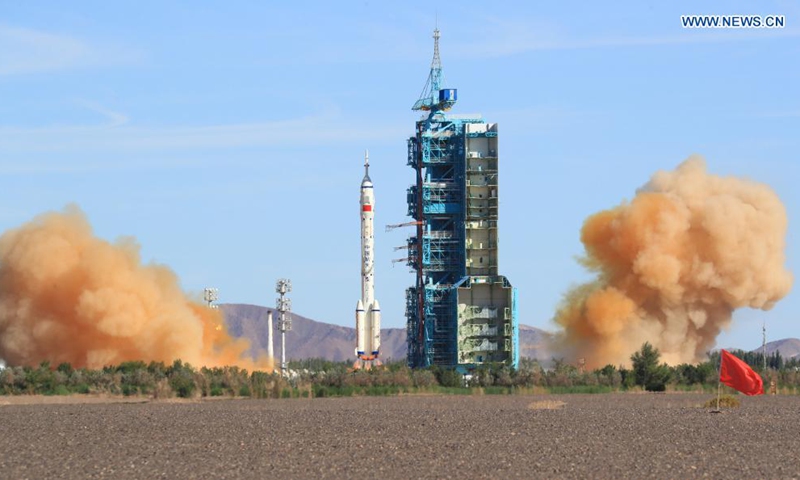
The crewed spacecraft Shenzhou-12, atop a Long March-2F carrier rocket, is launched from the Jiuquan Satellite Launch Center in northwest China's Gobi Desert, June 17, 2021. (Xinhua/Ju Zhenhua)
Emphasis on speed, safety
Compared with the previous Shenzhou series, the new model has greatly shortened the time of its space travel from launch to docking, reducing the duration from over 40 hours in the Shenzhou-11 mission in 2016 to the current 6.5 hours.
It took the US' SpaceX Crew Dragon capsule, which carried four astronauts to the International Space Station in late April, 23 hours to deliver humans to the orbiting lab after the launcher liftoff, which is nearly four times longer than that of China's Shenzhou-12.
The newly adopted autonomous rendezvous and docking capability, first used in the Tianzhou-2 mission in late May, helped the craft to realize a docking with the space station's core module in eight hour. Originally it took two days.
The success also shows that China has developed a highly advanced automation technology application in space and space tracking and monitoring capabilities, Wang Ya'nan, editor-in-chief of the Aerospace Knowledge magazine, told the Global Times on Thursday.
One of the key technological advances lies in the Guidance, Navigation & Control (GNC) subsystem of the Shenzhou-12 manned spacecraft, the core subsystem in charge of a series of operations from emergency rescue upon launch and altitude control during space flight, to the rendezvous and docking with the space station, the Global Times learned from state-owned space giant China Academy of Space Technology (CAST) on Wednesday.
The GNC system was first adopted onboard China's manned spaceship in 1999, and has been fully updated based on Shenzhou-11's technical status. It uses units that had been verified from previous launches, including those from the Tianzhou-1 cargo spacecraft, the new-generation manned spacecraft, and the Chang'e-5 spacecraft, while updating system functions to adapt to more complex situations in the space station construction phase, and greatly improving the Shenzhou-12 performance which shows fast, autonomous docking capability.
Developers have also prepared a backup plan that allows manual operations in case an error occurs during the spacecraft's autonomous docking with the core module. If the measurement or control functions for positioning the craft fails, the three astronauts aboard can observe their position through camera images and perform manual docking with the core module's cross target.
Making the safety of astronauts a priority, the Shenzhou-12 mission's research team has also developed a new emergency response system to ensure that the astronauts can be rescued both in space and at the launch site.
According to CAST, two Shenzhou vessels were transported to the launch site, which means that Shenzhou-12 has a backup that will stand by in the event of an emergency. The latter has the capability of being launched in eight and a half days to carry out space rescue work after the launch of the former.
A backup launch vehicle had also been transported to the launch site together with the Long March-2F Y12 carrier rocket, state rocket contractor China Academy of Launch Vehicle Technology said, ensuring immediate rollouts of launchers in case crew members at the space station require immediate pickups.
Following docking, the Shenzhou-12 will berth and fly with the Tianhe core module for three months, marking another first in China's space history.
Unlike China's previous Shenzhou craft, which returned to Earth from an orbit of fixed altitude, Shenzhou-12 will be able to return from a range of orbital locations, a design that is aimed to enhance the craft's adaptability and reliability for its journey back to the Earth, and it would also mark a first in China's space industry.

Space time. Photo: GT
Largest space population
As observers pointed out, starting Thursday, there will be at least three Chinese astronauts working for a long period in space for the construction of China's space station and future operations after 2022, and this number of space personnel is no less than that from the US and Russia, both major players in the International Space Station, or from any other countries.
The International Space Station's crew is now made up of seven astronauts, three of whom are from the US, and two from Russia. As for the last two, one is from Japan and the other the Europe Space Agency.
The three Chinese astronauts have brought the total space population to 10, bringing the number of human beings in space to double digits for the first time.
The Thursday mission has brought China to a world-leading position in terms of in-orbit astronaut population, as the country plans to rotate its astronaut candidates on a routine basis that ensures long-term human stays with no less than three people onboard the space station, which is at the same level as the US and Russia.
The fact that Chinese astronauts are excluded from ISS cooperation has motivated China's manned space industry to pursue independent development, observers noted.
"China has obviously developed a highly mature training mechanism for professional astronauts, and has also built up a pool of spacemen and spacewomen who are available to execute space flight mission when their names are called… China could compete with space powers like the US in those domains," said Wang, the magazine editor.
"It is an easy mathematical question. China plans to have three astronauts in orbit working and living for at least three months in its own space station and also to have another three as backup crew, and there will be rotations every few months… It will be difficult for even the US to keep up," Wang explained.
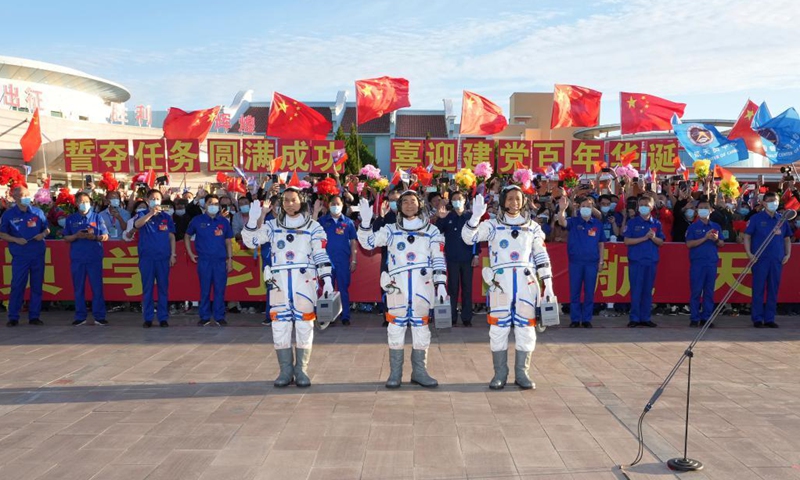
Astronauts Nie Haisheng (R), Liu Boming (C) and Tang Hongbo wave during a see-off ceremony for Chinese astronauts of the Shenzhou-12 manned space mission at the Jiuquan Satellite Launch Center in northwest China, June 17, 2021. (Xinhua/Li Gang)
China's progress in the manned space field should sound the alarm for the US, and prompt the latter to think twice about its current China policy, which is increasingly seeking the goal of containing and suppressing China's technological development and even of decoupling from China in the sector, Wu Xinbo, director of the Center for American Studies at Fudan University in Shanghai, told the Global Times on Thursday.
China has the capability and economic scale to build a relatively independent development system. US efforts to contain China could only slow but would never stop China's development, Wu noted.
"China is becoming the world's largest consumer market, which in return will provide an even stronger drive for technological development," he said.
The US could find a win-win situation not only in the space sector, but also in other domains if it works with China, or it will lose the vast Chinese market and also the opportunity for cooperation, Wu warned.
Once completed, China's space station will be able to operate in orbit for at least 10 years, a period that could be extended to 15 years under proper maintenance, making it the only operational space station when the ISS retires in 2024.
Also, many netizens recalled upon June 17, 1967, when China announced a successful H-bomb test and on the same date, hailing that China has and will always create its own path to development, regardless whatever exterior obstacles.

